After leaving Ligue 1 side Strasbourg in late-May 2021 having spent 5 years at Stade de la Meinau during which time he re-established Strasbourg as a top-flight club, achieving promotion in his first season in charge and keeping them up in all following campaigns, Thierry Laurey took on a new challenge this past summer when he agreed to take charge of Paris FC and lead their promotion push.
The former player of The Parsians’ city rivals PSG has thus far done a decent job at Stade Charléty as he’s helped them to earn 51 points from their 26 games so far this term, which places them second only to Toulouse in France’s second-tier right now, with Les Violets leading Laurey’s side by just three points at the time of writing.
Under the 58-year-old, who cites former Bordeaux, Saint-Étienne and Montpellier boss Jean-Louis Gasset as his coaching inspiration, Paris’ success thus far has come largely as a result of their dominance in transitions, in particular, the transition to attack.
Paris have made the joint-second most counter-attacks (three per 90) in the league this term, while they’ve scored the second-most goals (39) while generating the second-highest xG too (39.99). The Parisians have been a difficult counter-attacking force for their Ligue 2 opponents to deal with this term and this piece will be a tactical analysis of how Laurey’s philosophy, strategy and tactics have helped his team to be such a threat on the counter this term. I hope that this tactical analysis highlights what has made Paris one of Ligue 2’s most formidable sides this season and illustrates why I believe they’re set to challenge at the top of France’s second-tier right up until the season’s climax.
Defensive shape and press
Paris have primarily lined up in a 4-2-3-1 under Laurey this term, though not exclusively with the 4-1-4-1, 4-4-2 and 5-3-2 also having been used at points by The Parisians in 2021/22. As may be somewhat implied by my description of this team as a ‘counter-attacking force’ in the intro to this tactical analysis, Laurey’s side isn’t a heavily possession-based one. They’ve managed to retain an average of 50.7% possession this season, sitting them in seventh place in Ligue 2’s possession table.
Linked to their comfortability without the ball is their relatively high PPDA of 12.76. This isn’t an extremely high PPDA in actuality if compared with teams from other leagues but looking at it through the Ligue 2 lens, we see that this gives Paris the third-highest PPDA in the division, which is a strong indicator that they press with the third-lowest intensity in the league on average.
This isn’t to say that Paris just drop into a mid-to-low block, allowing the opposition to do what they want at the beginning of their attacks, however. The Parisians are still active in the high-block phase, with particular pressing triggers evident in their play that, when performed effectively, help them to force turnovers in advanced areas of the pitch and create dangerous counter-attacking opportunities. That said, it would still be fair to say that Laurey’s side is often relatively passive in the high-block phase, with a lower intensity in this phase and a lower line of engagement than most Ligue 2 teams.
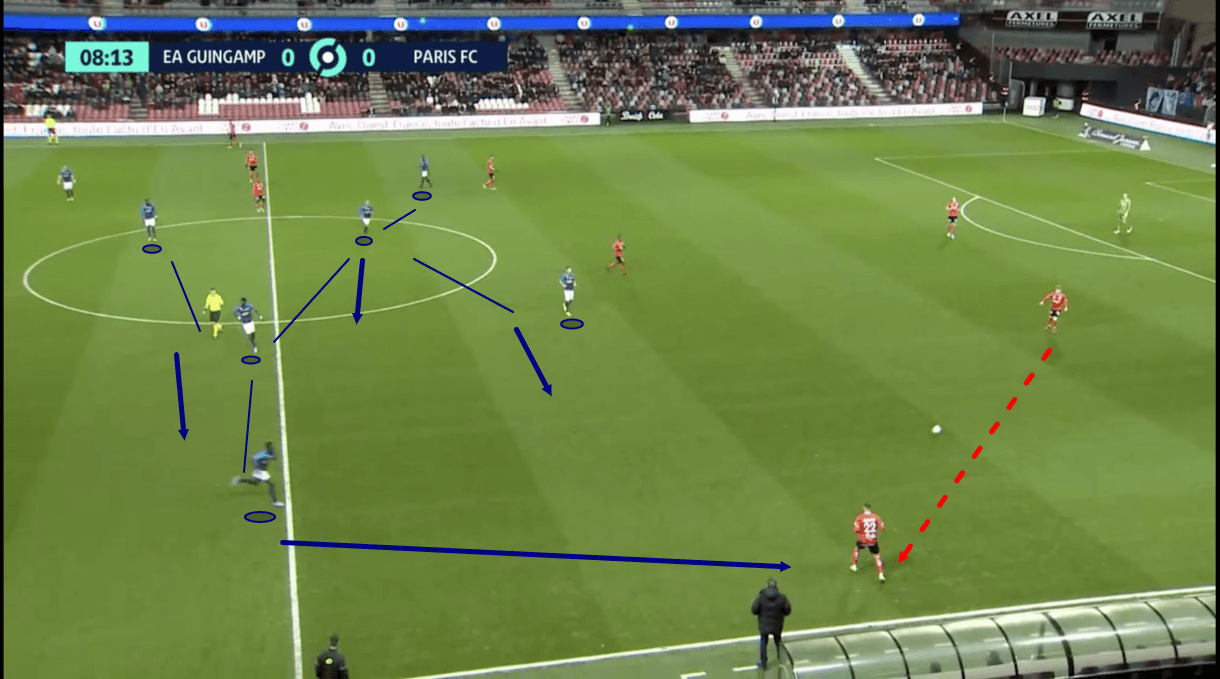
Paris are typically happy to sit off a bit until the ball makes it towards the middle third of the pitch, which represents their usual line of engagement under Laurey. Figure 1 shows an example of how their shape looked in a recent Ligue 2 clash with Guingamp where they operated in a 4-2-3-1 sometimes but also switched to a 4-1-4-1 for parts as we see in the image above, where the right holding midfielder advanced positionally to join the ‘10’ as a second central midfielder in front of the left holding midfielder who sat deep and behind the centre-forward.
This image shows a good example of Paris’ position-oriented zonal marking system which places great emphasis on organisation and discipline. Players protect their zones, remaining rigid in their shape until the ball enters their particular zone beyond the line of engagement. We see the ball entering the Paris right-winger’s zone in figure 1 and the player is in the process of aggressively closing him down while the rest of Paris’ shape shifts over to retain a degree of compactness between the players — including the aggressive right-winger — as well as to congest space around the ball carrier and prevent him from finding an easy way through the press. The rest of the shape won’t shift over too much as they want to continue retaining access to the opposite wing while they also aren’t willing to get too aggressive to force the turnover. They just want to support the pressing winger and continue making it difficult for the opposition to find a way through them.
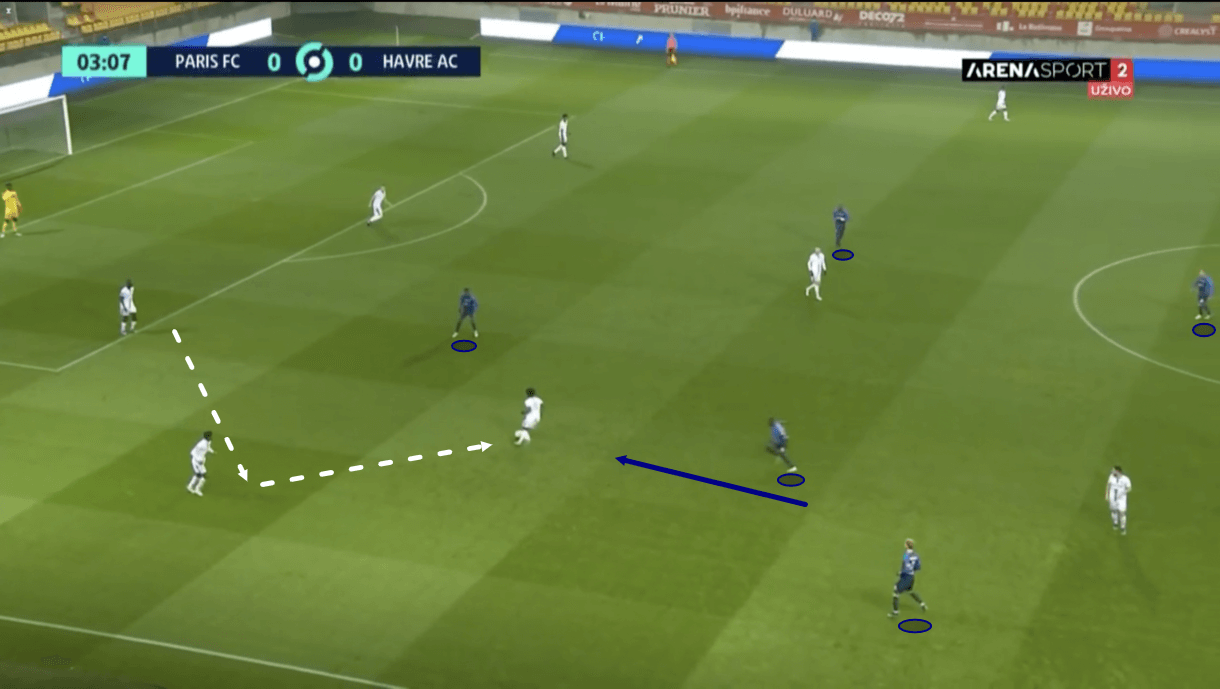
These principles ring true for Paris regardless of shape. Figure 2 shows an example of the opposition playing around Paris’ centre-forward and sending the ball into midfield. As the ball gets towards the edge of the middle third, Paris’ near central midfielder responsible for this zone jumps into action and begins closing down the receiver while keeping a progressive passing option in his cover shadow. With a potential sideways passing option made difficult due to pressure from another Paris player from behind, the passer is ultimately forced to play a negative pass to the left centre-back which then leads to the ball moving out to the opposition’s left wing-back.
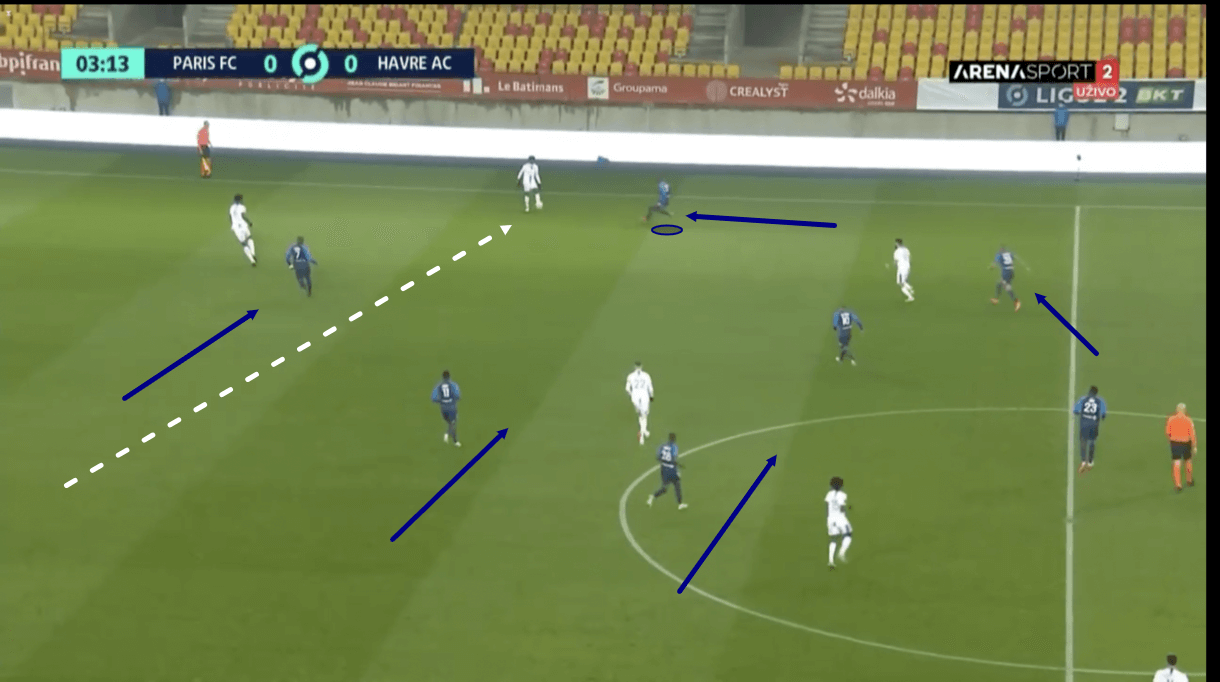
After having been given a moment to reorganise when the ball was forced backwards, in figure 3 we see how Paris react in a way that’s now becoming familiar to us as we see more of Laurey’s team defending. The ball-near player responsible for this zone aggressively closes down the receiver on the wing while his teammates support him, with the backline and midfield line shifting over to ensure space is congested and the opposition have no easy routes through the defensive shape and around the pressing man.
As well as the general plan and organisation coming from Laurey, these defensive tactics require a lot of both physical and mental energy from The Parisians’ players to carry out the boss’ instructions effectively and diligently every time, making these defensive tactics work at stifling the opposition’s progression.
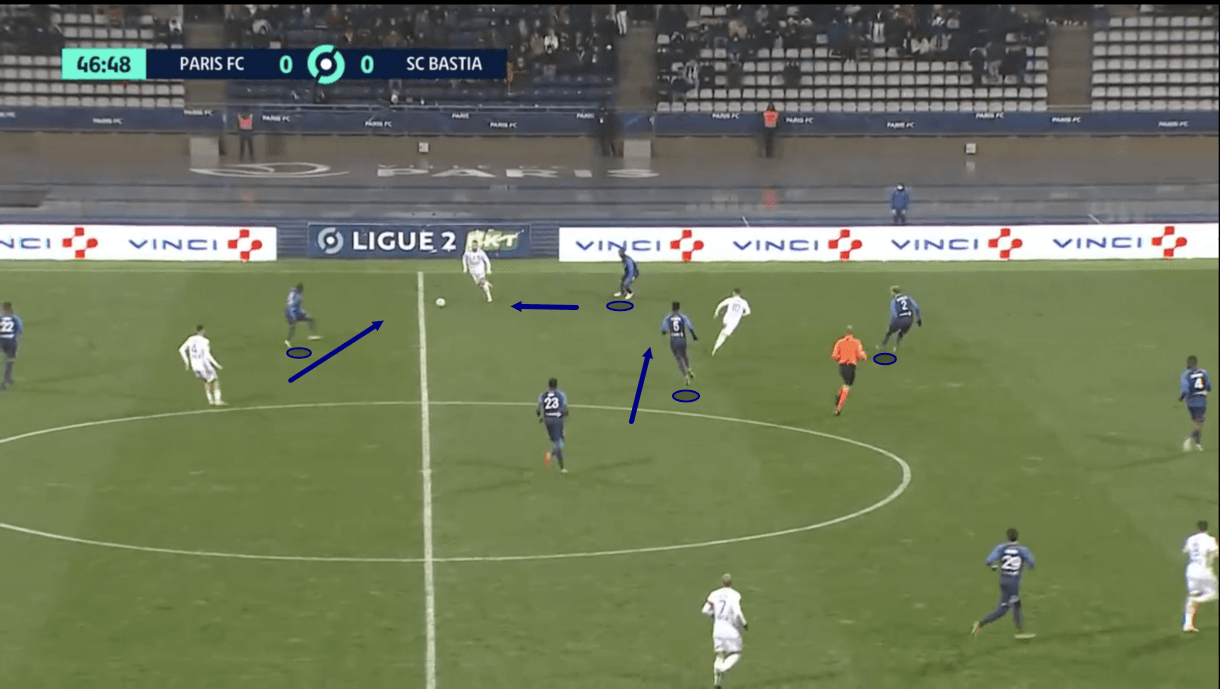
Figure 4 presents a somewhat similar example to figure 3 where the ball has been played out to the wing in the middle third of the pitch by the opposition, calling Paris’ winger into action to close down the receiver while the ‘10’, near holding midfielder and near centre-back all support closeby and the rest of the defensive shape shifts over to an extent as well to ensure compactness is retained. Here, due to the pressure from the winger and the support from Paris’ other defensive players nearby, the pass receiver is prevented from turning and given no positive passing/carrying options on receiving the ball. He’s forced to receive the ball in a negative stance with a negative body position and ultimately move backwards, highlighting the effectiveness of these defensive tactics in preventing the opposition from easily playing through The Parisians.
It’s worth noting how narrow Paris’ right-back, Maxime Bernauer, is positioned here. Instead of being positioned wide and perhaps closing the ball-carrier down himself, he stays in a narrow position, retaining a great deal of compactness with the rest of the backline, preventing gaps from opening in this space between them. It’s very common to see Paris’ backline act in this way in terms of their positioning and it appears to be another clear instruction coming from the boss for the backline to play conservatively, protecting the centre of the pitch and the space between them before all else.
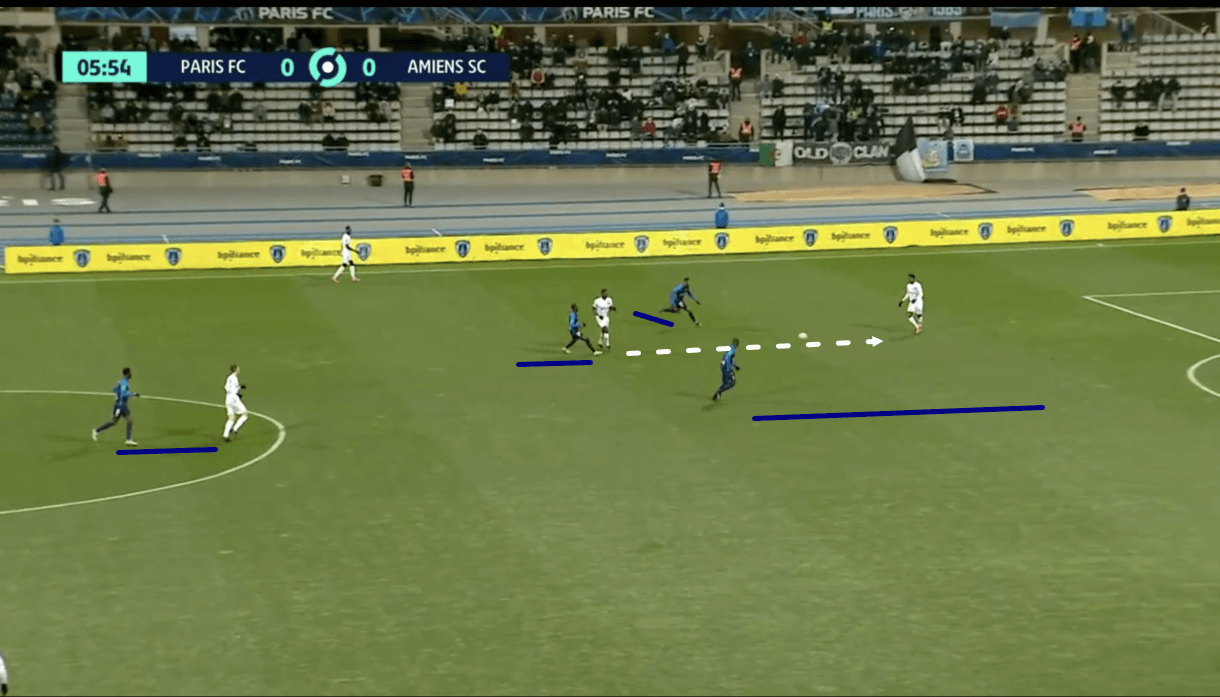
One common pressing trigger that’s evident within Paris’ game in the high-block phase is the backwards pass, which we see an example of in figure 5. Here, as the opposition made it towards the edge of the middle third, playing a pass to the holding midfielder, the receiver immediately attracted aggressive pressure from a previously passive Paris player who prevented the man from turning and forced a backwards pass to the centre-back, which we see in action above.
This pass acted as a trigger for the left-winger and striker to dramatically increase their intensity and as play moves on here, we see the left-winger close down the centre-back aggressively while keeping the right-back in his cover shadow, thus preventing that passing option from opening up, while instead of making a beeline for the receiver as well, the centre-forward intelligently cuts off the passing lane between this centre-back and his central defensive partner. This move was intelligent from the centre-forward as Paris benefit more from having another possible path out of trouble cut off than they do from having another player charging at the ball carrier, considering that the left-winger is already performing this role. After cutting off the passing lane, the centre-forward could then press while keeping the passing option in his cover shadow similarly to the left-winger but it was a wise move to not just go straight towards the centre-back.
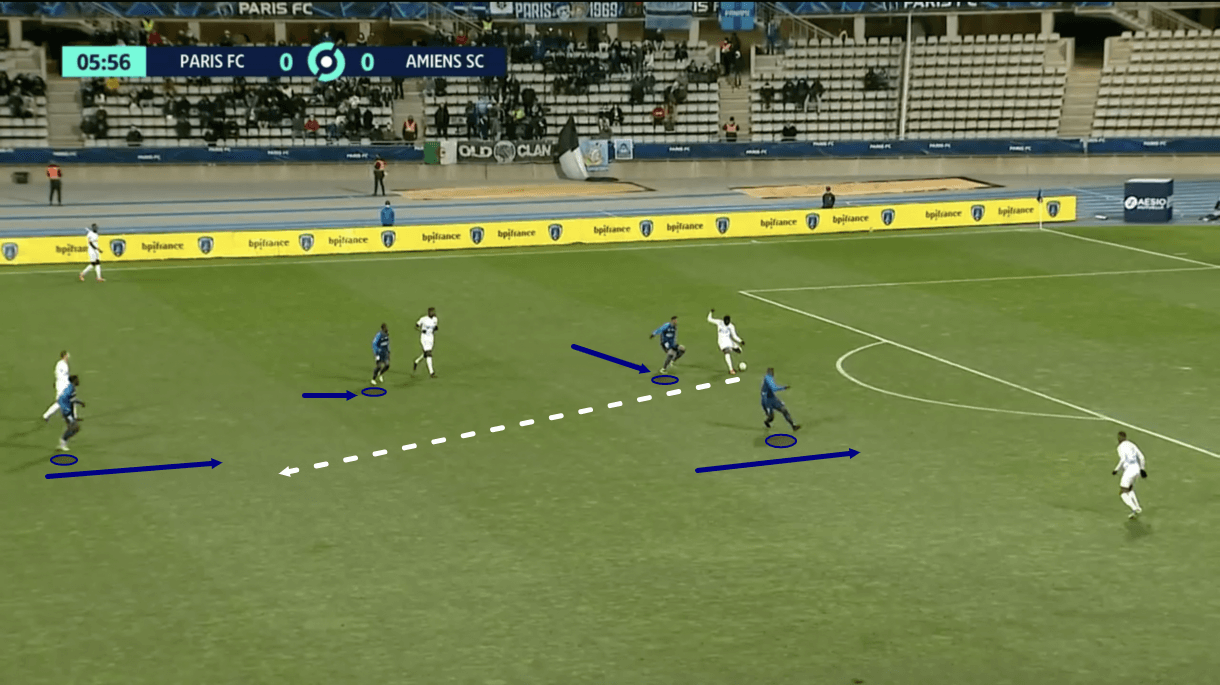
As we progress into figure 6, we see how this pressure paid off. The under-pressure centre-back was short of decent options and was ultimately forced into a rushed decision by the pressing players around him. The centre-back tried to split the left-winger and centre-forward to play the ball into midfield but Paris’ more aggressive holding midfielder was alert to the pass attempt and ended up intercepting the ball just on the edge of the middle third before it reached its intended target.
From here, the holding midfielder was able to quickly get his head up, spot some movement from the attacker ahead of him and send a through ball for him to chase, providing an example of how Paris’ organised defence and pressing tactics in the high-block phase can successfully create good goalscoring opportunities in the offensive transition from advanced areas.
Deeper defending
Of course, for the dominant counter-attacking side with the third-highest PPDA in the league, it’s not all just about what they do defensively close to the opposition’s goal but also what they do defensively when positioned deeper, which will be explored in the next section of analysis.
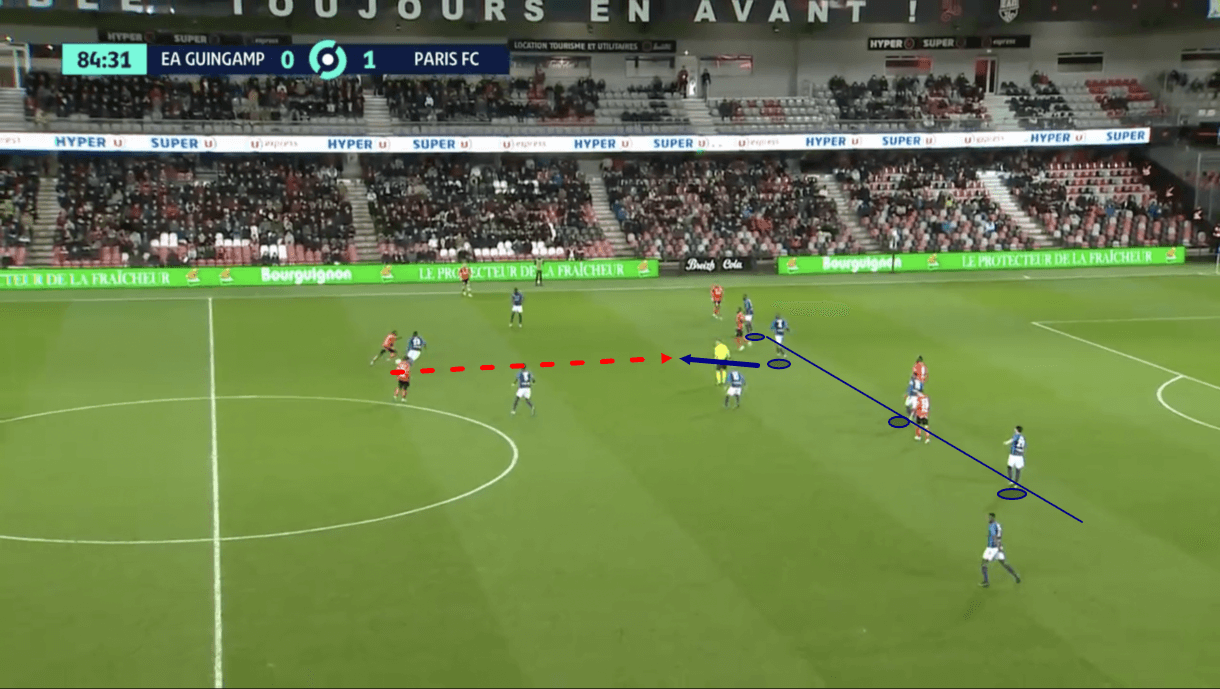
Figure 7, taken from the recent clash with Guingamp, shares another example of Paris in their 4-1-4-1 shape, this time when defending deep, however. Here, I want to focus on the positioning of The Parisians’ backline and wingers, in particular. As I touched on in the previous section, it’s clear that Laurey wants his backline to remain quite narrow and compact at all times to protect the centre and prevent potential gaps from forming between the players, which we see an example of here.
However, Paris do still need a presence on the wings, which is where the wingers come into play. Here, we can see how The Parisians’ left and right winger are both positioned deeper than the central midfielders — about in-line with the holding midfielder — and wider than the full-backs, occupying a unique protective space within their team’s shape which is designed to give the team quick access to an opposition wide man as the rest of the team’s shape adjusts in support should the ball be played to them.
Furthermore, we see how Paris’ back four remain steady on the edge of their own third here, refusing to drop deeper and invite pressure, instead holding their ground. This can be exploited by a very well timed run and through pass but this can be difficult for the opposition to pull off. Thus Paris’ quality defensive line and organisation makes them a formidable opponent to have to try and break down.
On this occasion, as play moves on, we see Guingamp’s passer attempt to play the ball to his teammate in the right half-space but Paris’ right centre-back jumps out of the backline to snatch the ball off the intended receiver’s toe. While maintaining a steady, brave backline, Paris’ defenders also retain the ability to defend aggressively when the opposition threaten to pass out of the middle third and into their third. Laurey wants his team to own the middle third of the pitch, preventing the opposition from entering it and if they do enter it, then preventing them from advancing any further by holding their ground right on the edge of their own third and being willing to jump into challenges/interceptions when the chance presents itself to guard against the opposition cutting through them. The aggressive nature of Paris’ defenders and, indeed, holding midfielders on the edge of their own third is one of the biggest reasons why The Parisians have made the fourth-most interceptions (42.21 per 90) of any Ligue 2 side this term.
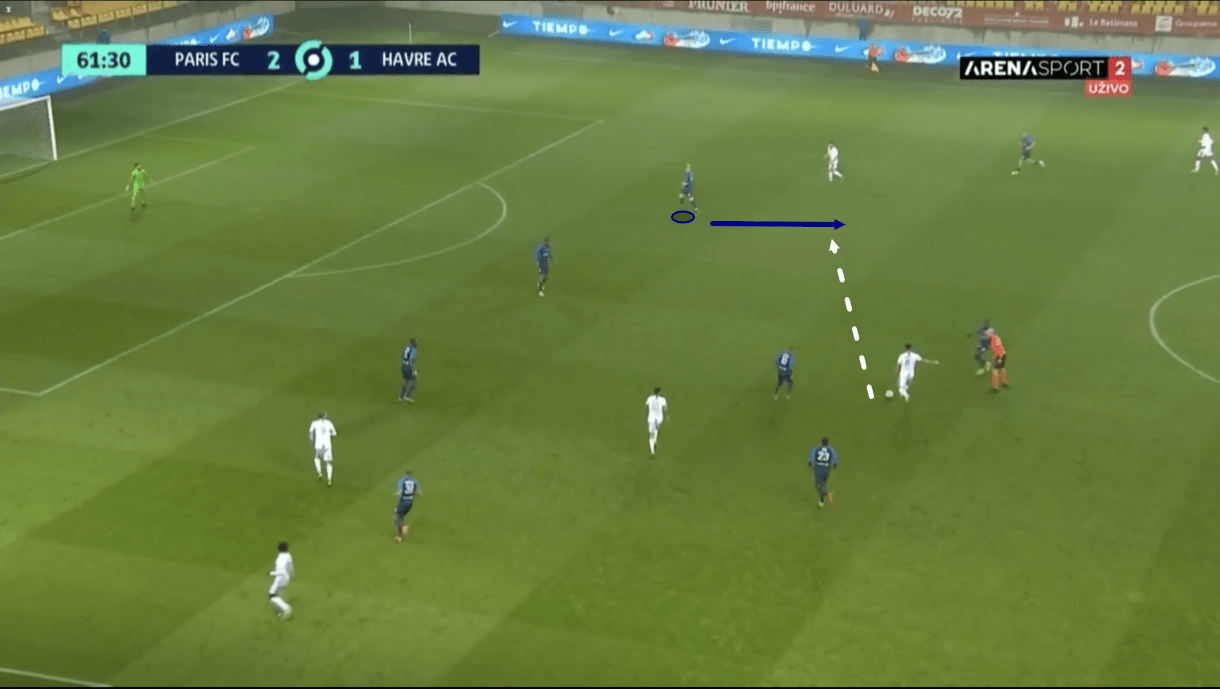
We see another example of this aggressiveness in figure 8, this time from Paris’ left-back. Here, the opposition have the ball in a central midfield position just outside Paris’ third. The ball carrier attempts to send a driven pass into the feet of an attacker on the right wing but Paris’ left-back was positioned very well and demonstrated excellent alertness to deal with the danger. As the pass was played, he dashed into the passing lane and cut the pass out, stopping the opposition from entering Paris’ third at the very last moment and creating an opportunity to counter-attack — an area in which The Parisians thrive.
This is an important point to note when it comes to Paris’ aggressive defenders and tendency to make last-ditch interceptions before the opposition enters their third of the pitch. One benefit is that this stops the opposition attack, but at the same time, these interceptions create excellent opportunities to hit the opposition in transition when they’re disorganised and less prepared to deal with a Paris attack while Paris are in a phase of play in which they’re very well prepared for. This is a very favourable combination of factors for Laurey’s side which all stems from their aggressive interceptions on the edge of their own third.
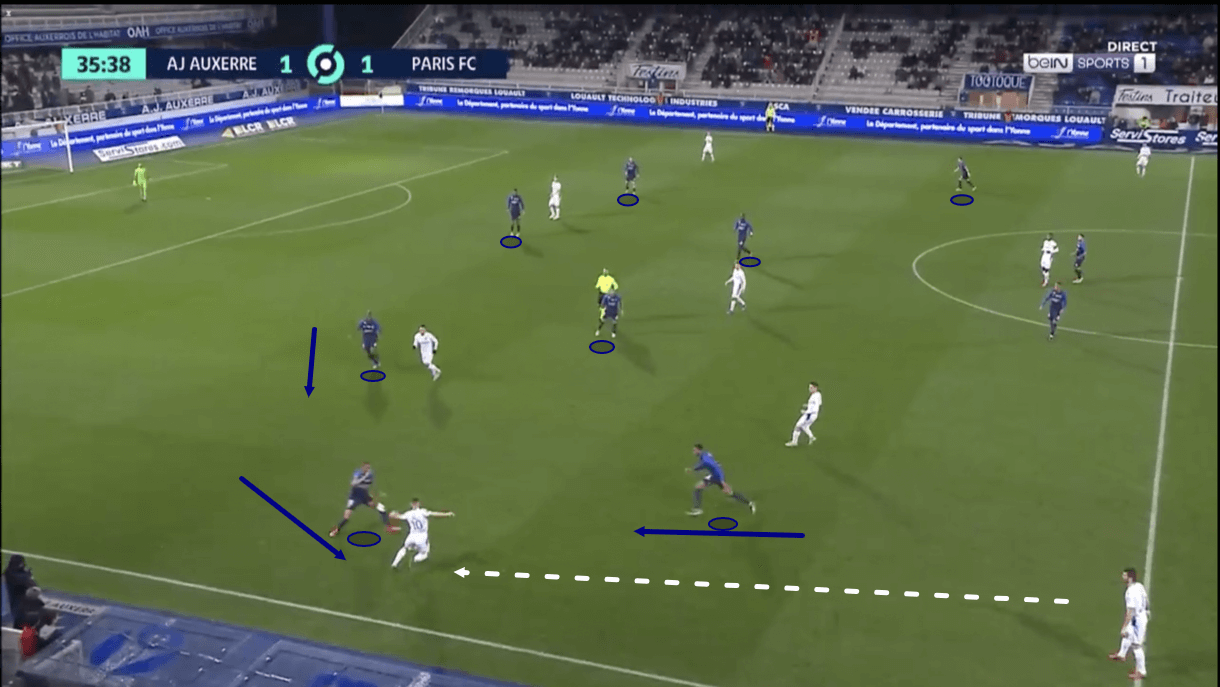
We see another example of a deep interception that in turn created a good counter-attacking opportunity for The Parisians in figures 9-10. Firstly, figure 9 shows Paris’ opponents Auxerre in possession high on the left wing, which has attracted pressure from Paris’ right-back, which then leads to that player getting supported by the rest of The Parisians’ shape, especially the near winger, near centre-back and near holding midfielder. Again, just like when the opposition centre-back came under intense pressure in figure 6, this forced a rushed decision from the winger who attempted to send the ball into midfield to escape the pressure on the wing and continue pushing his team forward.
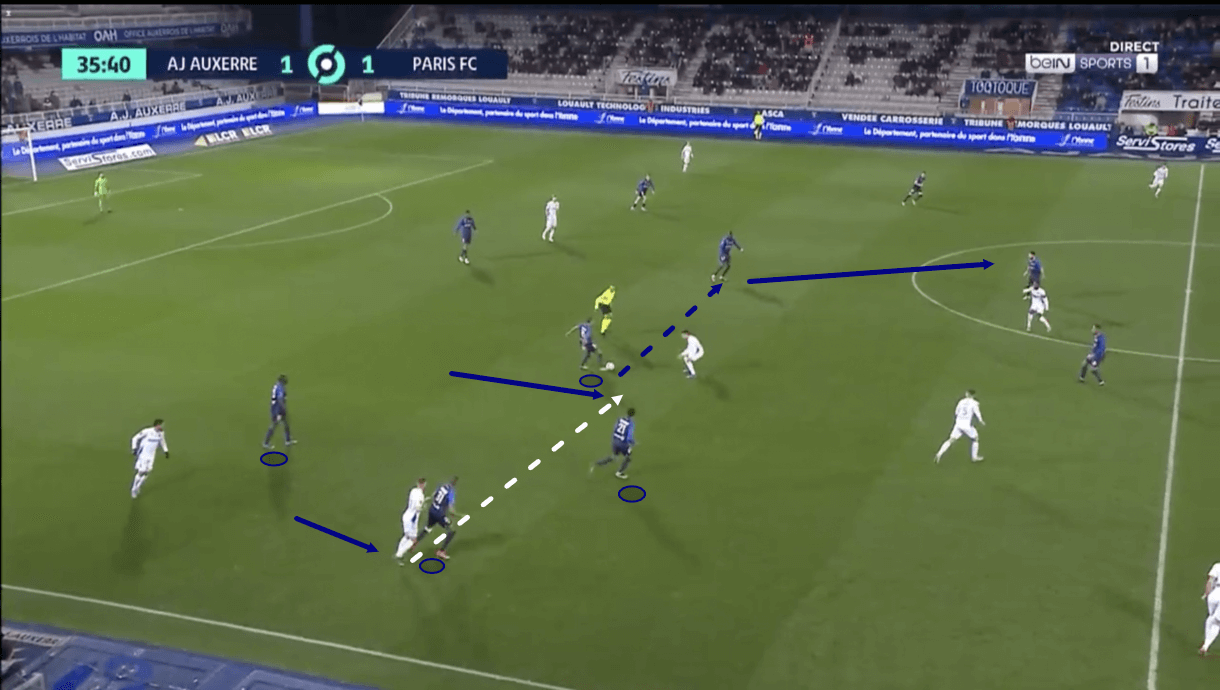
As figure 10 shows, the pass into midfield was misjudged as it directly led to an interception from Paris’ near holding midfielder who had pushed over in support of the pressing right-back. After regaining possession via an interception just on the edge of his own third, the holding midfielder was then able to quickly turn and find a teammate in space, with this player then carrying the ball forward and driving Paris upfield, creating a good counter-attacking opportunity for The Parisians yet again following some pressure from those near the ball carrier and some aggression on the edge of their third to pull off the interception.
Laurey’s side consistently perform these basic defensive principles to a high standard this term, hence why they’ve been so good at creating counter-attacking opportunities this season and been a significant threat in this area, as well as guarding their third.
In possession
The final section of analysis here will focus on a couple of aspects of Paris’ strategy and tactics in possession and how they are relevant to the team’s dominance in transition.
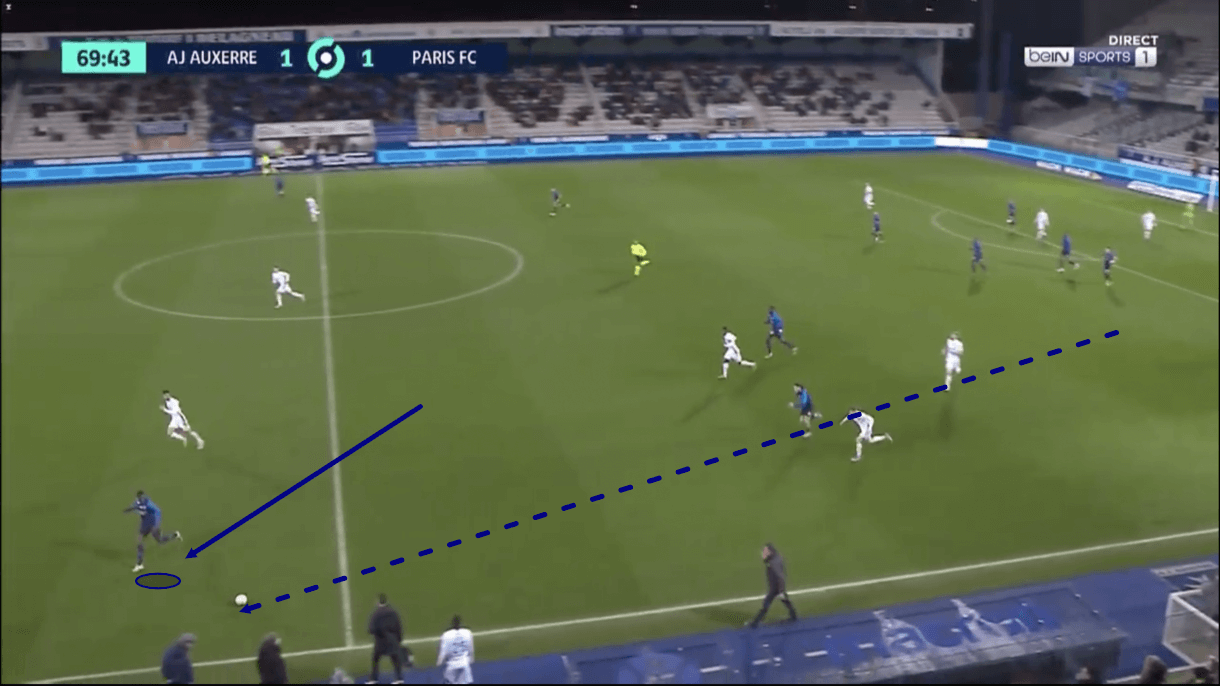
In figure 11, we see an example of Paris attacking the left-wing on the counter, having just regained possession on the edge of their box before playing the ball upfield with the aim of hitting the opposition hard in transition to exploit the team that had just been on the attack, with the majority of their team sent forward. Here, we see Paris’ centre-forward at the time having moved from the centre to the left wing to exploit some space where it was available and give his deeper-lying teammates and outlet to use at the other end of the pitch.
Attackers’ movement is so important to Paris’ counter-attacking strategy and tactics as this is key to taking advantage of the opposition’s disorganised shape in transition, as well as key to giving the other Paris players good passing options immediately after the turnover occurs so they can hit the opposition as quickly as possible to better take advantage of the transition rather than wait an extra second or two and perhaps allow the opposition to organise themselves better.
Back after figure 6, the striker’s movement to exploit space centrally between the two centre-backs after the transition occurred was crucial to creating a quick goalscoring chance but here, we see the opposite — the striker moving from the centre to the wing to exploit space here as it opens up.
It’s common to see Paris aim to exploit the wings when countering from a deeper area because when teams send bodies forward in attack, they’ll aim to protect the centre which can allow the wings to open up and become vulnerable to attacks. Laurey’s men are aware of this and the attackers use this knowledge when moving to give their teammates an option in transition. Here, the centre-forward shifted out wide to exploit space and aim to get around the opposition backline, which was a good move that also stretched the defence and then created more room centrally for teammates to potentially exploit as they advance upfield too if he’s unable to go the distance alone, which wouldn’t be too shocking from the position we see him in above.
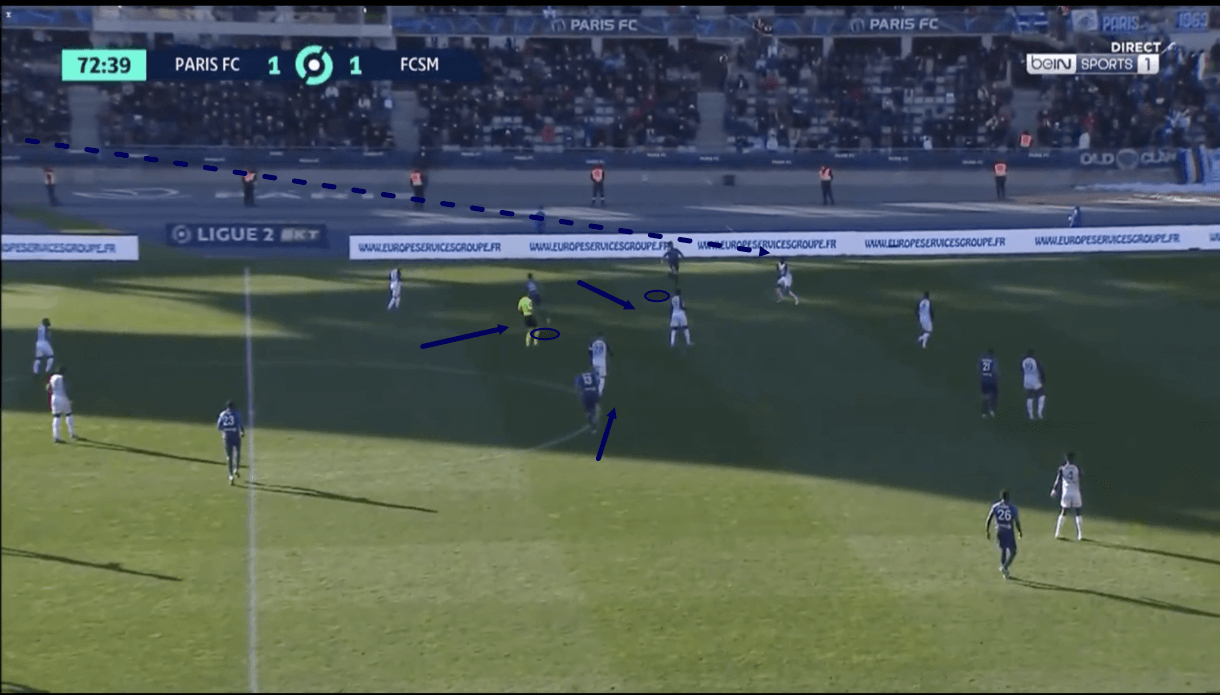
Lastly, in figures 12-13, we see how Paris use long balls to the wings to their advantage to manufacture transitions. Firstly, in figure 12 we see that Paris have just sent a long ball upfield to the left-wing, with the opposition’s right-back best-placed to win the aerial ball at this moment. Paris’ left-winger is nearby but not challenging very aggressively, while no other Paris players are near the intended drop zone.
It’s common to see teams — especially transition-based teams — play long balls to the wings like this in a seemingly hopeless and aimless manner. However, these long balls are far from hopeless and aimless, in fact they’re very calculated. The purpose of this long ball wasn’t for the winger to win the aerial duel, rather it was for the winger — or, indeed, one of his nearby teammates who have crowded around getting tight to other nearby opposition players — to win the second ball after the opposition full-back knocks it down, which is exactly what happens here. This is something we see EPL side Liverpool do quite often with long balls from Virgil van Dijk to Mo Salah. You don’t think of ‘wide target man’ when you think of Salah, nor should you as it’s not his role despite often being the closest Liverpool player in the vicinity of lofted long balls from the back.
The aim is for the team to be structurally sound and organised enough that after the opposition full-back knocks the ball down, one of their players will be the one positioned best to win the second ball and kickstart an aggressive counter-attack from an advanced position.
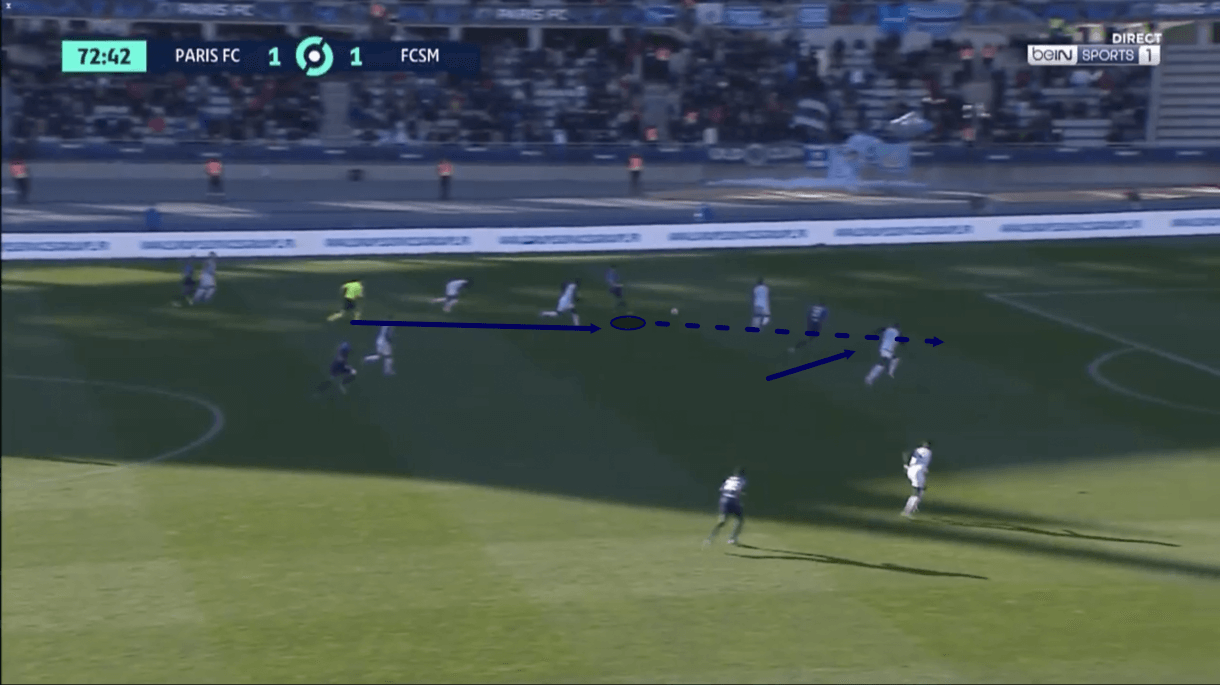
After the left-winger won the second ball following figure 12, he started driving forward in possession and ended up sliding a well-timed and well-weighted through ball into the path of the centre-forward who’d made a good run between the centre-backs as space began appearing between them. This highlights how this tactic can be very successful for Paris in manufacturing opportunities for the transition.
Conclusion
To conclude this tactical analysis piece, I hope it’s clear from my analysis how Paris’ defensive organisation and excellent execution of Laurey’s basic principles as outlined in this analysis have contributed to the team not only getting to this point of the campaign with the third-fewest goals conceded (22) but also the second-most goals scored and second-best xG, as Paris rely heavily on counter-attacks and their defensive strategy and tactics are crucial to creating opportunities for them.





Comments